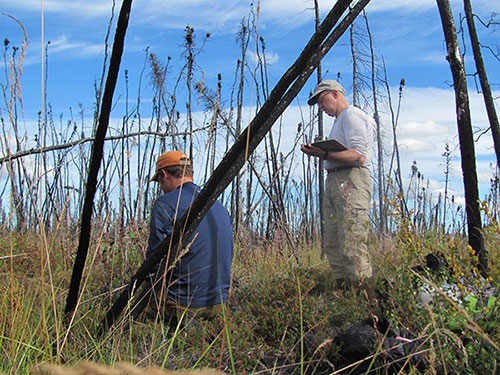
Scientists predict slower permafrost greenhouse gas emissionsBy MARIE THOMS April 09, 2015
Scientists say that may allow society more time to adapt to environmental change.
A. David McGuire, right, and Tom Sinclair, left,
Permafrost soils contain carbon in the form of organic material, such as dead plants and animals. As the climate warms and permafrost thaws, that organic material decomposes and releases carbon dioxide and methane into the atmosphere, which in turn creates even more warming. In high-latitude regions of the Earth, temperatures have risen 0.6 degrees Celsius per decade during the last 30 years, which is twice as fast as the global average. Permafrost has warmed nearly 11 degrees Fahrenheit in the past 30 years, according to co-author Vladimir Romanovsky, a permafrost expert with the UAF Geophysical Institute. In the 1980s, the average temperature of permafrost in Alaska, Russia and other Arctic regions was nearly 18 degrees Fahrenheit. Now the average is just over 28 degrees Fahrenheit. Permafrost contains twice as much carbon as is currently in the atmosphere. Two decades ago, scientists thought that, as permafrost thawed, carbon would be released suddenly. They thought that this “carbon bomb” would significantly accelerate climate warming. “The data from our team’s syntheses don’t support the permafrost carbon bomb view,” said McGuire. “What our syntheses do show is that permafrost carbon is likely to be released in a gradual and prolonged manner, and that the rate of release through 2100 is likely to be of the same order as the current rate of tropical deforestation in terms of its effects on the carbon cycle.” Many climate modelers do not incorporate the effects of carbon and methane release from permafrost thawing into their models. McGuire, Romanovsky and their co-authors hope the new findings will help modelers prioritize the inclusion of those effects in climate models. “If society’s goal is to try to keep the rise in global temperatures under two degrees Celsius and we haven’t taken permafrost carbon release into account in terms of mitigation efforts, then we might underestimate that amount of mitigation effort required to reach that goal,” McGuire said. Scientists in the Permafrost Carbon Network plan to continue to help the modeling community refine their models to include permafrost carbon and its fate in a warming world. They recommend improved observation methods, including using remote sensing to measure real-time carbon dioxide and methane emissions from permafrost regions.
On the Web:
This column provided as a public service by UAF Institute of Arctic Biology.
|
||
